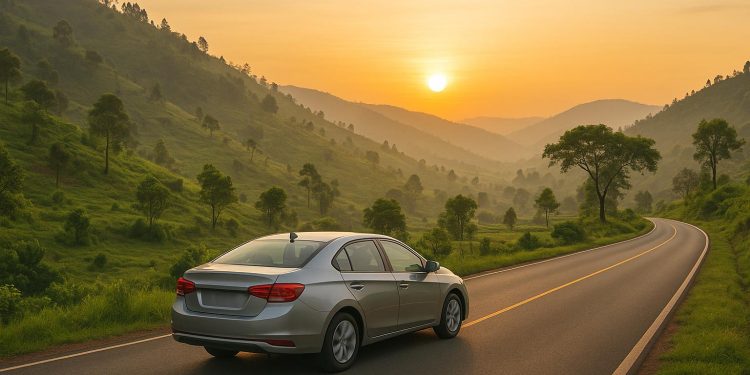Fuel prices in Rwanda are rising, but you can save money with smarter driving habits. Here’s how you can cut fuel costs by up to 25% while driving more efficiently:
- Check your tire pressure regularly: Properly inflated tires improve mileage by 0.6–3%.
- Drive at steady speeds: Avoid sudden acceleration or braking to save up to 25% on fuel.
- Plan your routes: Use navigation apps to avoid traffic and combine errands into one trip.
- Turn off your engine during long stops: If idling for over 30 seconds, switch off to conserve fuel.
- Keep up with car maintenance: Routine tasks like oil changes and spark plug replacements can improve fuel economy by up to 10%.
These small changes reduce fuel use, lower expenses, and help your car perform better. Start with one habit today and see the difference it makes.
5 Driving Hacks To Save Money On Gas
Keep Your Tires Properly Inflated
If you’re looking for an easy way to save on fuel costs, keeping your tires properly inflated is a great place to start. Tires are the only part of your car that touches the road, so their condition directly impacts fuel efficiency. In fact, properly inflated tires can boost your gas mileage by 0.6% to 3%, which can add up to noticeable savings over time.
Why Tire Pressure Matters for Fuel Efficiency
When your tires are under-inflated, they create more rolling resistance, forcing your engine to work harder. For every 1 PSI drop in tire pressure, fuel efficiency decreases by about 0.2%. While that might sound small, the effect multiplies across all four tires and hundreds of miles. Beyond saving fuel, proper inflation also helps your tires wear evenly, extending their lifespan.
"Under-inflation causes tires to flex more as they roll down the highway and can hurt a truck’s overall fuel efficiency, due to the simple fact that under-inflated tires force a vehicle’s engine to work harder", explains Brian Buckham, general manager for product marketing at Goodyear Commercial Tire Systems.
A 2003 Department of Transportation study revealed that only half of all tires were within 5 PSI of their recommended pressure. This highlights how many drivers may be wasting fuel simply due to improper tire inflation.
Steps to Check Your Tire Pressure
To ensure your tires are at the correct pressure, follow these simple steps:
- Check when tires are cold: Tire pressure should be measured when the car has been parked for at least three hours or driven less than a mile at moderate speed.
- Find the recommended PSI: Look for the recommended tire pressure on a sticker inside the driver’s door jamb or in your owner’s manual. Note that front and rear tires might require different pressures.
- Use a tire gauge: Remove the valve cap, press the gauge firmly onto the valve stem until the hissing sound stops, and read the pressure. Digital gauges display the reading on a screen, while standard gauges use a measurement bar with etched units.
- Inflate to the correct PSI: Use a personal tire gauge and an air compressor for more accurate results than gas station equipment. If checking warm tires at a gas station, inflate them to 4 PSI above the recommended cold pressure and recheck once cooled.
- Recheck after inflating: After adding air, check the pressure again. If you overinflate, release air until it’s at the right level, but avoid driving on overinflated tires.
"To gain the benefits of fuel efficiency, tires need to be inflated to the proper pressure for the specific load to get the maximum benefit. Tire inflation contributes to more than fuel efficiency. Proper tire pressure contributes to maximum total performance including wear, retreadability, casing endurance, and traction", says Michelin’s Crehan.
Make it a habit to check your tire pressure monthly. This small effort can lead to consistent fuel savings and better overall performance.
Drive at Steady, Moderate Speeds
The way you drive has a direct impact on how much fuel your car consumes. By adopting smoother driving habits, you can not only save on fuel costs but also reduce wear and tear on your vehicle.
Why Steady Speeds Save Fuel
Keeping a consistent speed allows your engine to operate more efficiently, avoiding the extra fuel burn that comes with frequent speed changes. In fact, driving steadily and making gradual speed adjustments can lead to fuel savings of up to 25%.
Road conditions also matter. Smooth, well-maintained roads minimize tire friction, meaning your car requires less energy to move forward. When roads are in good condition, it’s easier to maintain a consistent speed, further improving fuel efficiency.
Research shows that fuel consumption is significantly lower at moderate speeds. For example, driving at around 56 mph (90 km/h) uses 23% less fuel compared to 68 mph (110 km/h) and 30% less than 75 mph (120 km/h).
"Smooth braking and steady acceleration will reduce your emissions and save you fuel." – Esso.co.uk
In Rwanda, where highway speed limits are often around 50 mph, you’re already in the range for efficient fuel use. The key is maintaining that speed consistently and avoiding unnecessary acceleration or braking.
Smooth, steady driving isn’t just about speed – it’s also about avoiding abrupt maneuvers that waste fuel.
Avoid Hard Acceleration and Sudden Braking
Aggressive driving habits like rapid acceleration and hard braking can burn through fuel unnecessarily. Hard acceleration forces your engine to work harder than it needs to, while sudden braking wastes the energy used to reach your speed. A more thoughtful, anticipatory driving style can help.
By planning ahead and keeping an eye on traffic flow, you can reduce the need for abrupt stops or turns. For example, if you notice traffic slowing or see a red light up ahead, start easing off the gas instead of braking at the last second.
Maintaining a safe following distance is another way to drive more smoothly. The three-second rule is a helpful guide: pick a fixed object ahead, and ensure at least three seconds pass between when the car in front of you passes it and when you do.
Whether you’re navigating Kigali’s highways or rural roads, giving yourself extra time to reach your destination can help you avoid the stress and aggressive driving that wastes fuel and increases risks.
Beyond fuel savings, smooth acceleration and braking also reduce wear on critical components like your transmission, brakes, and engine. A gentler driving style benefits both your wallet and your vehicle in the long run.
Plan Your Routes and Combine Trips
Once you’ve fine-tuned your driving habits, the next step to improving fuel efficiency is smart route planning. By organizing your trips and errands more thoughtfully, you can cut down on driving distance and idle time, saving both fuel and time.
Use Navigation Apps to Find Fuel-Saving Routes
Navigation apps are a great tool for identifying routes that help you use less fuel while avoiding traffic jams.
For example, Google Maps offers a feature that highlights fuel-efficient routes with a green leaf icon. This feature considers real-time traffic, road conditions, and even your engine type to suggest the best option. To get the most accurate recommendations, enable the "Prefer fuel-efficient routes" setting and specify your engine type in the app. Google Maps analyzes factors like average fuel consumption, steep hills, stop-and-go traffic, and road types to recommend routes that balance efficiency and travel time. It typically suggests the fuel-saving option if the arrival time is close to the fastest route.
Waze is another great app, providing real-time traffic updates and alternate routes to help you avoid congestion. Whenever possible, plan your travel outside of rush hour to reduce time spent idling in traffic, which wastes fuel. If you can’t avoid busy times, these apps can guide you around the worst bottlenecks.
Once you’ve identified the most efficient route, take it a step further by grouping your stops along the way.
Combine Your Errands Into One Trip
One of the simplest and most effective ways to save fuel is by consolidating errands into a single trip. Instead of making separate drives to the bank, grocery store, and pharmacy, combine them into one well-planned route.
Timing also plays a role in efficiency. For example, group visits to places with similar hours of operation – like banks or government offices – so you can handle them all in one outing. Even leisure activities can be planned with fuel savings in mind. If you’re visiting friends or family in different parts of town, try scheduling those visits for the same day.
To make this easier, keep a running list of errands and appointments. This way, you can spot opportunities to combine trips and create a more streamlined and efficient plan for your day.
sbb-itb-7bc66b5
Turn Off Your Engine During Long Stops
Switching off your engine during long stops is a simple yet effective way to save fuel and reduce air pollution. Studies indicate that if your vehicle is stationary for more than 10 seconds, turning off the engine can lower fuel consumption, cut down emissions, and contribute to a cleaner environment. It’s a small habit that can make a big difference.
Modern engines are designed to handle frequent restarts without causing significant wear and tear. The impact of this practice is notable – start-stop technology in the United States alone has the potential to cut nearly 10 million tons of greenhouse gas emissions each year. Additionally, these systems can improve fuel efficiency by 3–10%.
When to Turn Off Your Engine
The general rule of thumb is to turn off your engine if you’re idling for more than 30 seconds. Some guidelines suggest waiting for a minute or more. Here are a few scenarios where this habit can be particularly helpful:
- Heavy traffic jams: If you’re stuck in a complete standstill, shutting off the engine can save fuel and reduce emissions.
- Waiting for passengers: When you’re parked and waiting for someone for more than a minute, it’s better to turn off the engine.
- Railway crossings: If a long freight train is passing and delays are expected, switching off the engine can help conserve fuel.
For vehicles without automatic start-stop systems, restarting the engine after a short stop – especially when it’s still warm – is generally easy. However, frequent starts with minimal driving can strain your battery. If you follow this practice often, it’s a good idea to have your battery checked annually to ensure it’s in good condition.
Keep Up with Regular Car Maintenance
Taking care of your car isn’t just about keeping it running – it’s also key to saving on fuel costs. Regular maintenance ensures your vehicle operates efficiently, with all its components working in harmony. In fact, a well-maintained car can improve fuel economy by up to 10%, which can add up to noticeable savings over time.
For example, fixing a car that’s clearly out of tune can increase gas mileage by an average of 4%. And if your oxygen sensor is faulty, replacing it could boost your mileage by as much as 40%. These simple fixes make the most of all the fuel-saving strategies you’ve put into practice.
Important Maintenance Tasks for Fuel Savings
Certain routine maintenance tasks can have a big impact on how much fuel your car uses:
- Oil Changes: Keeping up with oil changes is critical for engine performance. Clean oil reduces friction between engine parts, helping your car run smoothly and consume less fuel. Stick to the manufacturer’s recommended schedule and use the correct oil grade to improve fuel economy by 1%–2%.
- Air Filter Replacement: A clogged air filter can hurt your mileage. Replace it every 12,000–15,000 miles or at least once a year. If you’re driving in dusty conditions or heavy traffic, you may need to replace it more often to avoid losing up to 20% in fuel efficiency.
- Spark Plugs: Faulty or worn spark plugs can seriously affect fuel combustion, potentially costing you an extra 94 cents per gallon. Regularly replacing them can improve fuel efficiency by anywhere from 4% to 40%.
- Oxygen Sensors: These sensors play a vital role in combustion. Replacing them every 100,000 miles ensures your engine burns fuel as efficiently as possible.
- Mass Air Flow Sensor: A clean mass air flow sensor ensures accurate fuel injection, which directly impacts fuel economy.
Choose Quality Fuel
Beyond maintenance, the type of fuel you use also matters. High-quality fuel keeps your system clean, including parts like fuel injectors and filters, ensuring smooth fuel flow and efficient combustion. Regularly cleaning your fuel system helps your engine perform at its best, which translates to better mileage.
Skipping maintenance doesn’t just hurt your wallet at the pump – it can lead to bigger, more expensive problems down the line. Staying on top of these tasks not only saves fuel but also keeps your car running efficiently, reinforcing all your efforts to maximize performance and reduce costs.
Conclusion
Incorporating these habits into your driving routine not only helps you save money on fuel but also makes your overall driving experience smoother and more efficient. For Rwandan drivers, these five simple adjustments can significantly lower fuel costs while improving the quality of time spent behind the wheel. Studies show that adopting fuel-efficient driving techniques can result in annual fuel savings of up to 17%, translating to hundreds of dollars saved each year. Since your driving habits directly impact fuel consumption, these changes empower you to take control of your expenses.
"Adopting new and improved driving behaviors not only makes car travel safer, but it can also contribute to significant savings at the gas pump." – AAA
The best part? These habits are easy to start. Begin with small steps like checking your tire pressure regularly or turning off your engine during extended stops. These require little effort but can make a noticeable difference in fuel efficiency. Something as simple as keeping your tires properly inflated can yield quick and tangible benefits.
Once you’ve mastered the basics, focus on more advanced techniques like planning your routes efficiently and adopting smoother driving practices. Gentle acceleration and maintaining a steady speed can go a long way – frequent speed changes, for instance, can increase fuel use by 20%. Consistency behind the wheel is key.
From ensuring proper tire inflation to keeping up with regular vehicle maintenance, each habit plays an important role in maximizing fuel efficiency. Beyond saving money, these practices also reduce wear and tear on your car, lower emissions, and enhance overall driving safety. Smooth driving, for example, puts less strain on your brakes and transmission, while regular maintenance keeps your engine running optimally.
The best time to start is now. Pick one habit that feels easy to integrate into your routine and stick with it. As it becomes second nature, gradually add the others. Within a few months, you’ll likely notice a drop in fuel expenses and a more enjoyable, stress-free driving experience. These changes don’t just benefit your wallet – they also extend the life of your vehicle and make every drive more pleasant.
FAQs
How often should I check my tire pressure to save fuel?
You should check your tire pressure at least once a month to help keep your fuel usage in check. When tires are underinflated, they create more rolling resistance, which forces your car to burn more fuel than necessary.
For accurate results, make sure to check your tire pressure when the tires are cold – either before you start driving or after the car has been parked for a few hours. Then, compare the pressure to the recommended levels found in your vehicle’s manual or on the sticker inside the driver’s side door. Properly inflated tires don’t just improve fuel efficiency – they also last longer and make your driving experience safer.
How can I plan fuel-efficient driving routes in Rwanda?
To cut down on fuel use, start by planning your trips wisely. Use GPS tools like Google Maps to steer clear of traffic jams and avoid routes with steep hills. Stick to main roads when you can – they tend to be smoother and more efficient. Another smart move is to combine several errands into one trip, which helps save both time and gas. While driving, aim to keep a steady speed and anticipate stops to avoid unnecessary speeding up or braking, both of which can burn extra fuel.
How does regular car maintenance help you save on fuel costs?
Regular maintenance for your car isn’t just about avoiding breakdowns – it can also cut down on fuel consumption and save you money. Keeping your engine running smoothly, fixing problems like faulty oxygen sensors, and ensuring your tires are at the right pressure all contribute to better fuel efficiency.
Take underinflated tires, for instance. When your tires don’t have enough air, they create more rolling resistance, which means your engine has to work harder and burns more gas in the process. On the other hand, a well-maintained engine ensures fuel burns efficiently, improving overall gas mileage. These straightforward habits can lead to noticeable savings at the pump over time.
Related posts
- 5 Tips for Negotiating Car Prices in Rwanda
- Cheapest cars to maintain in Rwanda
- Top 5 Cheapest Cars to Maintain in Rwanda
- Common Car Problems in Rwanda (And How to Prevent Them)





